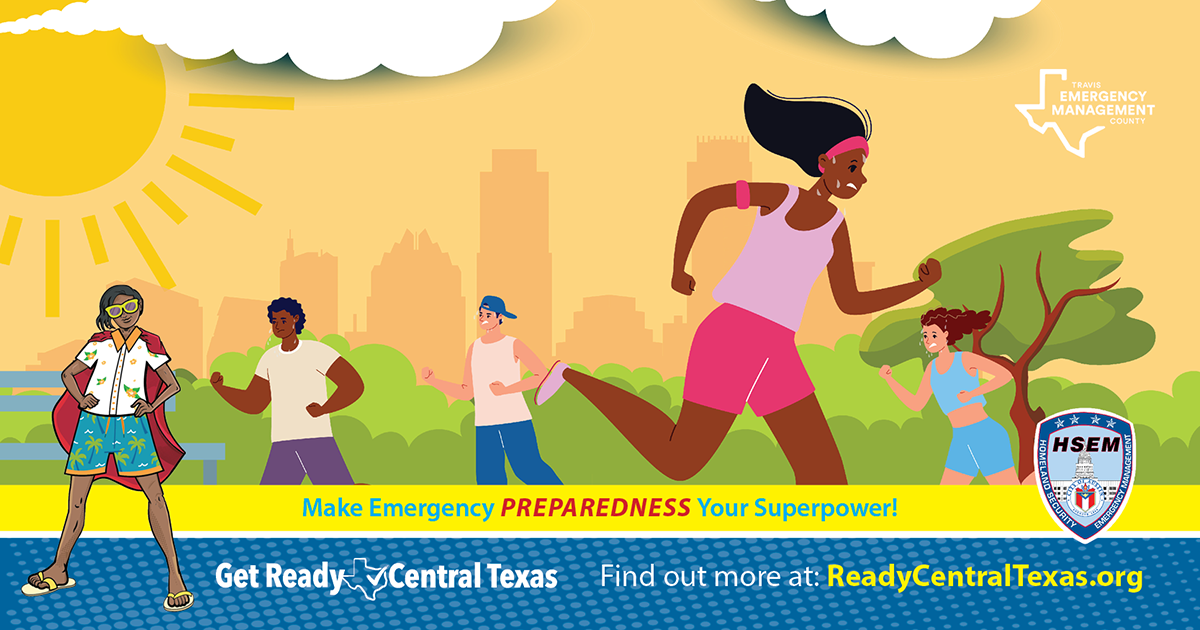

First 100-Degree Day in Austin: Heat Safety for Summertime
Over the weekend, temperatures are expected to reach 100 degrees in Austin for the first time this year. The City encourages residents to take precautions when spending time outdoors and to be aware of safety tips to prevent a heat-related illness or emergency.
“Summer is here and we want all residents and visitors to be prepared for the impacts of extreme heat,” said Office of Homeland Security and Emergency Management Director, Ken Snipes. “Everyone should prioritize the wellbeing and safety of themselves and others. Stay hydrated, seek shade and look out for signs of heat related illness.”
When temperatures reach triple digits, it’s important to protect people and pets. Find tips on staying cool and safe in the heat below.
Cooling Centers open all summer
City of Austin facilities, including recreation centers and libraries, are available as cooling centers during regular business hours. These facilities serve as temporary reprieve from the heat with indoor air conditioning. Service animals are welcome in the cooling centers. The cooling centers are not overnight shelters, and more details on locations and hours can be found at austintexas.gov/alerts. This webpage maintains critical emergency information in 13 languages.
Stay hydrated
Drinking water throughout the day can prevent a heat-related illness. If your pet is outdoors with you, bring plenty of drinking water for them as well as a collapsible bowl to keep your furry friend hydrated.
Avoid sugary or alcoholic beverages in the heat. If you are outdoors for a prolonged period or are participating in a high-energy activity or work, consider drinking an electrolyte containing beverage in addition to taking regular water breaks.
Look before you lock
Within just a few minutes temperatures inside a vehicle can become deadly during 80-degree weather. Life-threatening temperatures are reached even more quickly on a 100 degree day!
Always check the back seat of your vehicle for children, pets and adults before locking your vehicle. Heat stroke is the leading cause of non-crash vehicle-related deaths in children. If you see someone locked in a hot car, take action and call 911 immediately. It can save a life.
Use personal protection
You can protect yourself from heat-related illness by wearing light-colored, loose-fitting clothing along with a wide-brimmed hat. Apply and reapply sunscreen throughout your time outdoors and take breaks in the shade.
Practice water safety
Summer means more water activities, which have their own heat-related risks. If you are enjoying time on the lake or at the pool, assign someone in your party to be a spotter to watch and monitor all individuals while they are swimming. Always take time to identify a sober swimmer and designated driver.
Recognize heat-related illnesses
Heat exhaustion and heat stroke both impose serious threats. Knowing how to identify the symptoms of heat-related illnesses can save lives. Ensure you know the proper actions to take if someone experiencing one of these illnesses.
Heat stroke is a serious health risk and can cause permanent damage or death if emergency treatment is not given promptly. If you or someone you know is experiencing heat stroke, MOVE THEM, COOL THEM, CALL 911.
Heat stroke symptoms include:
-
Hot, red, dry or damp skin
-
Rapid and strong pulse
-
Throbbing headache
-
Confusion
-
Nausea or dizziness
-
Body temperature above 103 F
-
Lethargy or loss of consciousness
Heat exhaustion can progress into heat stroke within minutes if untreated. Move to a cooler and/or shaded area as quickly as possible, loosen the victim’s clothing and have them sip cool water slowly.
Heat exhaustion symptoms include:
-
Cool, pale, clammy skin
-
Weakness
-
Dizziness
-
Heavy sweating
-
Nausea or vomiting
-
Fast, weak pulse
Heat cramps, while the least threatening of heat-related illnesses, can still progress into heat exhaustion and heat stroke if untreated. If you begin experiencing muscle cramps in the heat, stop your physical activity, move to a cooler location, drink water and wait for the cramps to go away before doing any more physical activity.
If the cramps last longer than an hour, the victim is on a low-sodium diet and/or has heart problems, call 911.
For more heat safety tips and ways to identify and treat heat-related illnesses visit ReadyCentralTexas.org.
